2019.03.29Field Report
Being a Part of the "AKARI" Bringing Light to People Project, Report by Volunteer Employee Reporters
2015.11.06 Field Report
After super typhoon Haiyan wreaked havoc on the Philippines in November 2013, Panasonic joined in the disaster recovery effort by donating 1,002 solar lanterns to the Philippine Department of Social Welfare and Development (DSWD). A project member who visited the stricken region two years after the disaster filed this two-part report. In part two, we look at how the lanterns are being used in the stricken area.
Super typhoon Haiyan, known as Yolanda in the Philippines, caused over 6,000 casualties with more than an estimated 1.1 million homes lost. There was a shortage of many of essential relief supplies and no way to get more supplies to the victims because the airport was also destroyed and unusable.
An official from the DSWD said, "The first order of business was to clear the airport because everything depended on planes landing."
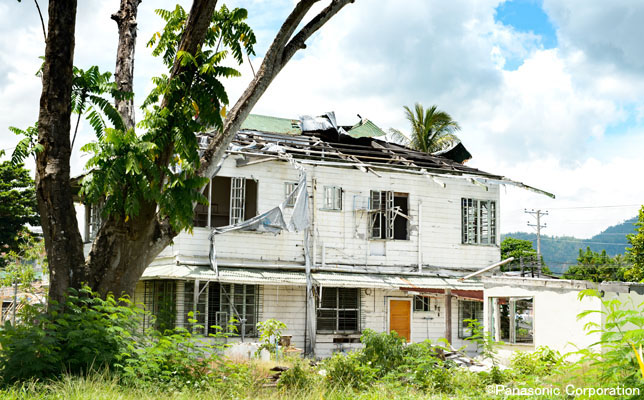
The storm surge also hit Bethany Hospital, and this private hospital's original medical ward is still in disrepair.
The governmental and private support groups in the Philippines, United Nations, and international NGOs all conducted their operations remarkably well when supplies started arriving. Despite their efforts, some people were beyond the reach of the relief efforts.
Although an international organization and an NGO distributed solar lanterns to many families in the area, there were still some who did not receive them and some whose lanterns stopped working for various reasons. Panasonic stepped in to help by providing solar lanterns to those, including 43 families living at the IPI bunkhouses.
People living in the camp told us they are still using the lanterns and showed us various ways they are putting them to use. The camp has streetlights, but looking around the grounds, we could see many areas that were dark. Several people told us they carry the lanterns with them when they go to the public toilets at night. The lanterns are also needed to do laundry during the evening because there are no lights at the washing facility.
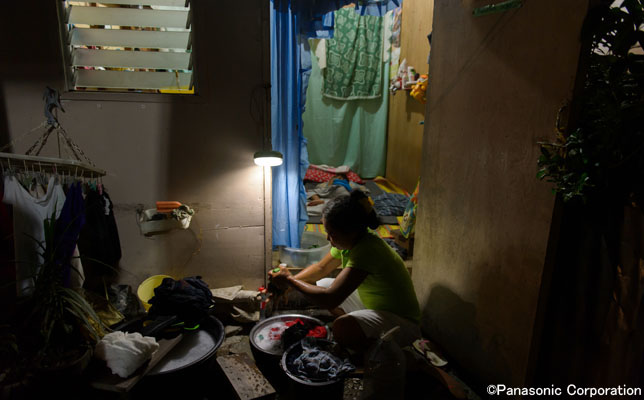
A woman washing clothes in front of her bunkhouse. The inside light provides some illumination, while the solar lantern shines directly on where she is working.
The basic function of solar lanterns is to provide light where electricity is not available. When we visited the temporary housing that had electricity, we realized that they also help in special ways in disaster areas.
This became very clear when we visited Gina, whom we introduced in the first part of this report. She said her daughter was using it to do her schoolwork. Kids using the lanterns for light to study by--we saw this in every village without electricity.
Yet, this camp did have electricity. Although it looked like the ceiling light was a bit too dim to read by comfortably, Gina told me something unexpected. Her daughter Jamaica's eyes had been damaged during the typhoon, and the stress of reading in the dim room light would damage her eyes even more. Having the solar lantern by her side was a huge help.
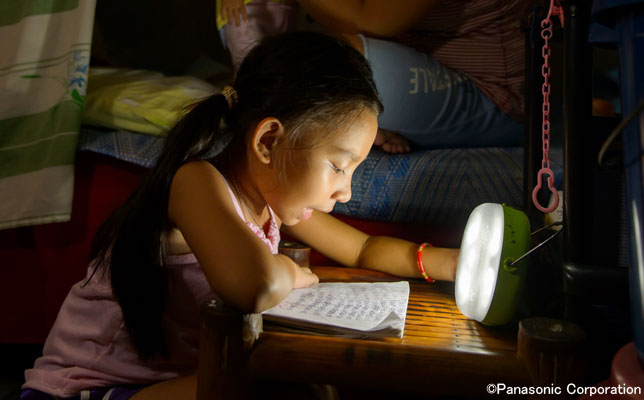
Jamaica studying at home in their IPI bunkhouse
Freda operates a small sari-sari convenience store in front of her home until 11 o'clock at night. The solar lantern hanging from the eaves casts light on the various goods she is displaying.
We wondered why she would be using a solar lantern when the government is paying for the electricity and she could easily just buy fluorescent light bulbs. The reason was that the DSWD is using taxes to pay for the electricity used by the people living in the camps and they have a limited budget for assisting the typhoon victims. The agency is trying to support the camp residents while encouraging them to be independent and not become over-reliant on the support. DSWD, therefore, provides electricity for the basic amount of lighting, and Freda must provide for her own light if she wants to keep the store open at night.
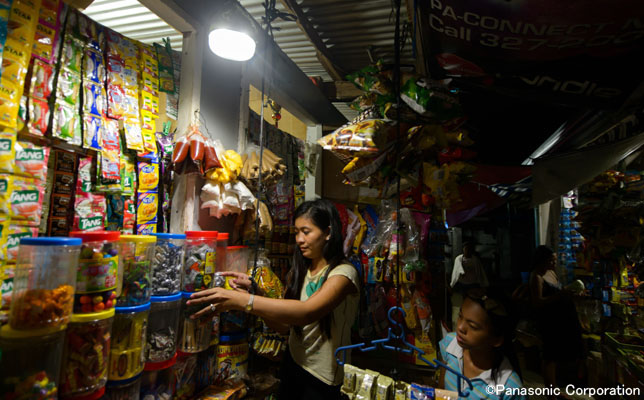
Freda opened a sari-sari store after her husband incurred a severe head injury during the typhoon and became unable to work. The store is their sole source of income for supporting their family.
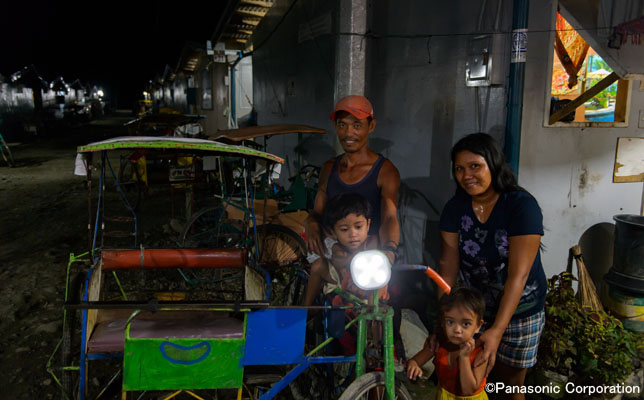
A taxi driver and his family. He uses a solar lantern as a headlight for his pedicab, a three-wheeled cycle rickshaw. Before using the lantern, he said he had almost gotten into an accident while driving in the dark and bumpy side street.
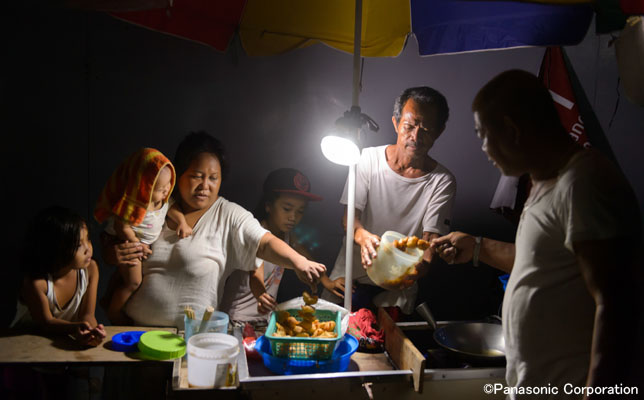
A food stall owner told us, "The solar lantern lets me stay open until I sell all of the fishballs I made that day. My wife uses the lantern when she goes to the market in downtown Tacloban in the early morning. It helps keep her safe when she's out."
The uses for the solar lanterns we donated to victims of super typhoon Haiyan are evolving from providing the minimum amount of light needed for daily living to helping people reestablish their independence as quickly as possible. However, a DSWD official said the solar lanterns will once again be needed to provide basic lighting in the new settlement.
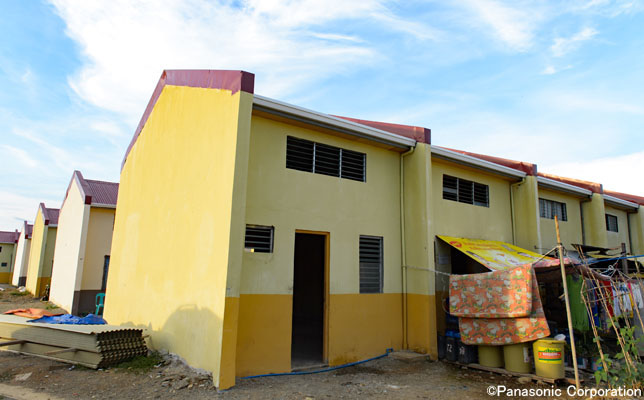
Permanent housing units under construction
The DSWD is advancing to the next stage of reconstruction and is hastening to relocate people from the temporary housing to newly constructed permanent housing units. The agency has negotiated several times with the landowners of the IPI bunkhouses and other temporary housing sites to extend the leases for using the properties. As the two-year mark from the typhoon approaches, the agency is moving ahead with the relocation even though electric lines have not yet been connected to the permanent houses.
When we visited in early September, 35 families were already living in permanent houses in the northern section of Tacloban. Without a source for electric power, the solar lanterns are once again a core component in their daily lives. One of the families living in the permanent housing showed us their solar lantern, which they said they use every day.
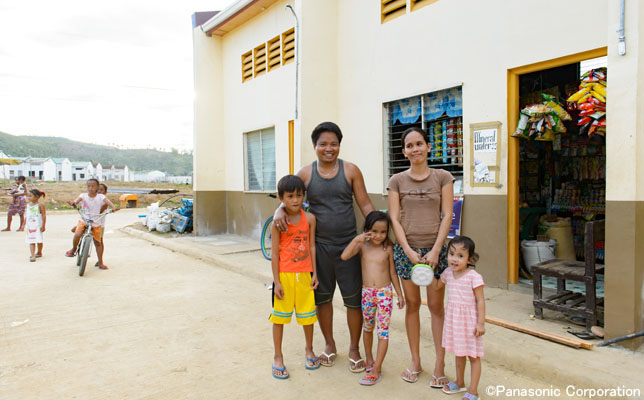
A family living in the newly constructed Ridgeview Park (a permanent housing facility built by the government for Yolanda survivors who lost their homes) on the northern side of Tacloban City for people who lost their homes during typhoon Haiyan.
Of course, the new homes will get power eventually. But the resilience we saw in the people we met at the temporary housing camp made us believe they will use their ingenuity to find new ways to use the solar lanterns even after the new homes receive electricity.
After visiting for two days, it was moving to see the creative ways that the solar lanterns were being put to use as people earnestly sought to reestablish their lives while living temporarily without electricity. I saw the potential for solar lanterns to play a role that goes beyond simply providing light in helping people reestablish their lives, and I rededicate myself to realizing our target of providing 100,000 lanterns to the world.
|
|